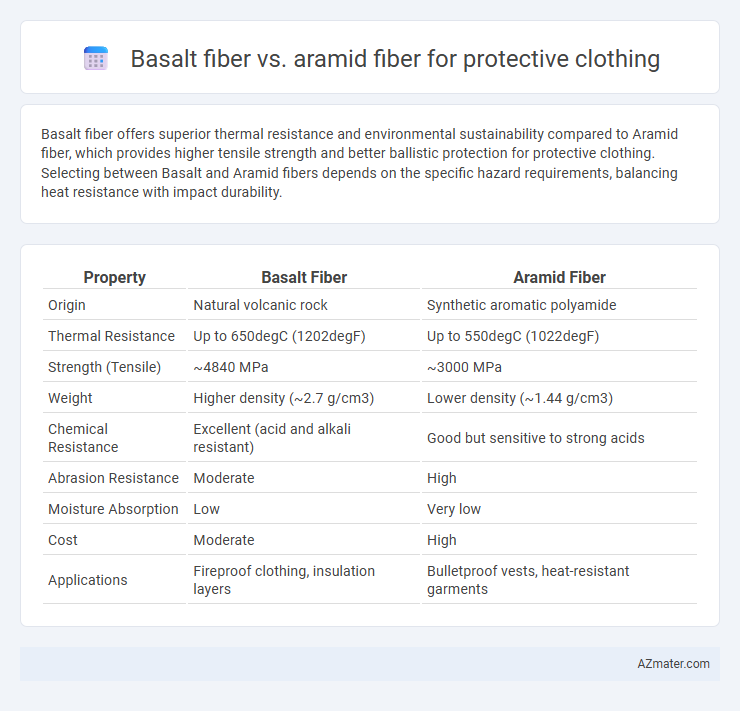Basalt fiber offers superior thermal resistance and environmental sustainability compared to Aramid fiber, which provides higher tensile strength and better ballistic protection for protective clothing. Selecting between Basalt and Aramid fibers depends on the specific hazard requirements, balancing heat resistance with impact durability.
Table of Comparison
| Property | Basalt Fiber | Aramid Fiber |
|---|---|---|
| Origin | Natural volcanic rock | Synthetic aromatic polyamide |
| Thermal Resistance | Up to 650degC (1202degF) | Up to 550degC (1022degF) |
| Strength (Tensile) | ~4840 MPa | ~3000 MPa |
| Weight | Higher density (~2.7 g/cm3) | Lower density (~1.44 g/cm3) |
| Chemical Resistance | Excellent (acid and alkali resistant) | Good but sensitive to strong acids |
| Abrasion Resistance | Moderate | High |
| Moisture Absorption | Low | Very low |
| Cost | Moderate | High |
| Applications | Fireproof clothing, insulation layers | Bulletproof vests, heat-resistant garments |
Introduction to Basalt and Aramid Fibers
Basalt fiber, derived from volcanic rock, offers exceptional thermal stability, high tensile strength, and excellent chemical resistance, making it a strong candidate for protective clothing. Aramid fiber, synthesized from aromatic polyamides, is renowned for its superior heat resistance, high strength-to-weight ratio, and outstanding impact resistance, commonly used in ballistic and fire-resistant garments. Both fibers provide unique advantages in protective applications, with basalt excelling in thermal and chemical durability, while aramid emphasizes flexibility, lightweight protection, and flame retardancy.
Key Properties of Basalt Fiber
Basalt fiber offers exceptional thermal resistance, high tensile strength, and excellent chemical stability, making it a superior choice for protective clothing exposed to extreme heat and harsh environments. Compared to aramid fiber, basalt fiber exhibits greater durability against UV radiation and moisture, enhancing its lifespan and performance in outdoor applications. Its non-toxic, eco-friendly composition further supports sustainability without compromising protective qualities.
Key Properties of Aramid Fiber
Aramid fiber exhibits exceptional heat resistance, high tensile strength, and excellent abrasion resistance, making it ideal for protective clothing used in firefighting and industrial applications. Its inherent flame-retardant properties and low flammability ensure reliable protection against extreme temperatures and mechanical hazards. Compared to basalt fiber, aramid fiber offers superior flexibility and lighter weight, enhancing wearer comfort without compromising safety.
Thermal Resistance Comparison
Basalt fiber exhibits superior thermal resistance compared to aramid fiber, maintaining structural integrity at temperatures exceeding 800degC, while aramid fibers typically degrade around 400degC to 500degC. The inherent mineral composition of basalt fiber provides enhanced flame retardancy and thermal stability, making it ideal for high-heat protective clothing applications. Aramid fibers, such as Kevlar, offer good thermal resistance but are more susceptible to thermal decomposition under extreme heat conditions.
Mechanical Strength and Durability
Basalt fiber exhibits superior tensile strength reaching up to 4840 MPa, offering enhanced puncture and abrasion resistance compared to aramid fibers, which typically have tensile strengths around 3000 MPa but excel in impact resistance and flexibility. Durability-wise, basalt fibers demonstrate excellent resistance to high temperatures and chemical corrosion, making them ideal for harsh environments, while aramid fibers provide exceptional UV and flame resistance but degrade faster under prolonged UV exposure. For protective clothing requiring a balance of mechanical strength and long-term durability, basalt fiber offers a robust alternative with higher structural integrity in extreme conditions.
Chemical and Environmental Resistance
Basalt fiber offers superior chemical resistance, maintaining integrity against acids, alkalis, and solvents, making it highly durable in harsh chemical environments. Aramid fiber exhibits excellent environmental resistance, particularly against heat and UV radiation, but can degrade when exposed to strong acids and prolonged moisture. Choosing between basalt and aramid fibers for protective clothing depends on the specific chemical exposure and environmental conditions encountered in the application.
Comfort and Wearability in Protective Clothing
Basalt fiber offers superior thermal insulation and breathability compared to aramid fiber, enhancing comfort in protective clothing for high-temperature environments. Aramid fiber provides exceptional strength and cut resistance, but its lower moisture-wicking properties can reduce wearability during extended use. Choosing basalt fiber improves wearer comfort without compromising protection, making it ideal for protective garments requiring durability and thermal comfort.
Cost and Availability Considerations
Basalt fiber offers a cost-effective alternative to aramid fiber, with raw material costs significantly lower due to basalt's natural abundance and simpler manufacturing processes. Aramid fiber, while providing high-performance thermal resistance, is more expensive and subject to supply chain volatility given its synthetic production. Availability favors basalt fiber, which benefits from widespread natural deposits and fewer geopolitical constraints, making it a more accessible choice for large-scale protective clothing production.
Applications in Protective Garments
Basalt fiber offers excellent thermal resistance and chemical stability, making it ideal for protective garments used in high-temperature environments such as firefighting and industrial heat shielding. Aramid fiber, known for its exceptional strength-to-weight ratio and flame resistance, is widely used in ballistic vests and cut-resistant gloves to provide superior protection against impact and abrasion. Both fibers contribute to advanced protective clothing solutions but are selected based on specific requirements like thermal endurance for basalt and high tensile strength for aramid applications.
Conclusion: Choosing Between Basalt and Aramid Fiber
Basalt fiber offers superior thermal stability and environmental resistance, making it ideal for high-temperature protective clothing applications. Aramid fiber excels in tensile strength and cut resistance, providing enhanced durability and abrasion protection in hazardous environments. Selecting between basalt and aramid fibers depends on specific protection needs, with basalt favored for heat resistance and aramid preferred for mechanical strength and impact protection.

Infographic: Basalt fiber vs Aramid fiber for Protective clothing
 azmater.com
azmater.com